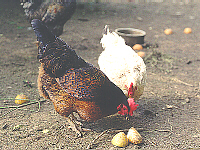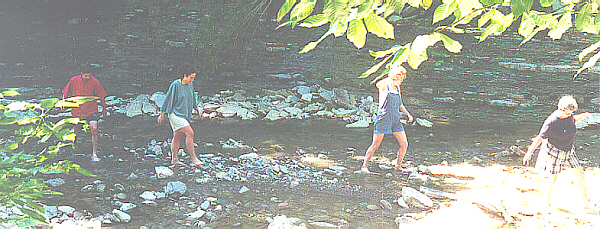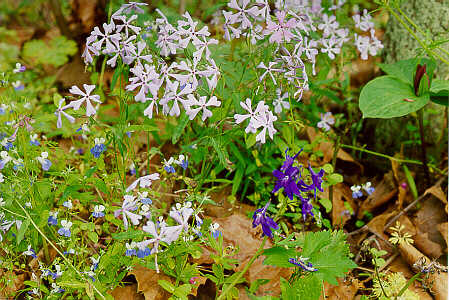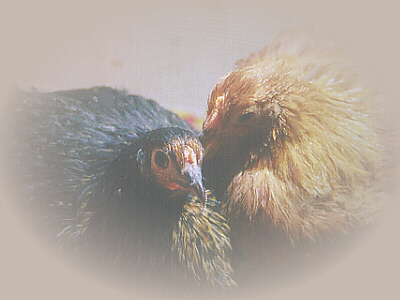 he
volleyball picnic at Farmer Melanie’s
he
volleyball picnic at Farmer Melanie’s
 house is just about over, now. Before they left, the last few visitors were
helping to take down the volleyball net and clean up after the picnic. The
tablecloths were washed, dried, folded, and taken into the house. Farmer
Melanie had used “real,” reusable plates and silverware rather than paper and
plastic that would end up in the landfill. Thus, someone was helping to wash
dishes. Several people volunteered to walk the property picking up trash
that had accidentally been left there, but thankfully, they found that not
much had been left behind. The chickens and the pig had a feast that night
as they “recycled” all the left-over food scraps.
house is just about over, now. Before they left, the last few visitors were
helping to take down the volleyball net and clean up after the picnic. The
tablecloths were washed, dried, folded, and taken into the house. Farmer
Melanie had used “real,” reusable plates and silverware rather than paper and
plastic that would end up in the landfill. Thus, someone was helping to wash
dishes. Several people volunteered to walk the property picking up trash
that had accidentally been left there, but thankfully, they found that not
much had been left behind. The chickens and the pig had a feast that night
as they “recycled” all the left-over food scraps.
Human Intervention

We humans are part of the world around us, the ecosystem in
which we live, and everything
we do will affect the world around us for the better or for the worse.
 Will we, via the laws we enact and the food we purchase, encourage small
family farms where the farmers care about their land, or support agribusiness
that’s only interested in making as much profit as
possible?
Will we, via the laws we enact and the food we purchase, encourage small
family farms where the farmers care about their land, or support agribusiness
that’s only interested in making as much profit as
possible?
 Will we help to preserve woodland wildflowers or replace them with non-native
grass lawns that are high maintenance and through the gasoline, fertilizers,
insecticides, herbicides, etc., that they require, contribute to air and
water pollution?
Will we help to preserve woodland wildflowers or replace them with non-native
grass lawns that are high maintenance and through the gasoline, fertilizers,
insecticides, herbicides, etc., that they require, contribute to air and
water pollution?
 These hens were hatched in the biology lab. We used a digital thermometer to
monitor the incubator temperature, not realizing it was calibrated 4° off.
That caused them to hatch with crippled right feet. In the “egg industry,”
they would be considered a waste of money, and would have been left to die.
These girls were several months old in this picture, and are now several
years old (and pampered). What is our responsibility with respect to the
health of our domestic animals — should we kill them for our convenience or
care for them (thereby, discovering how intelligent and loving they can
be)?
These hens were hatched in the biology lab. We used a digital thermometer to
monitor the incubator temperature, not realizing it was calibrated 4° off.
That caused them to hatch with crippled right feet. In the “egg industry,”
they would be considered a waste of money, and would have been left to die.
These girls were several months old in this picture, and are now several
years old (and pampered). What is our responsibility with respect to the
health of our domestic animals — should we kill them for our convenience or
care for them (thereby, discovering how intelligent and loving they can
be)?
 Knowing that most of the oxygen we need to breath is produced by trees, will
we work to save our natural areas or encourage the
bulldozers?
Knowing that most of the oxygen we need to breath is produced by trees, will
we work to save our natural areas or encourage the
bulldozers?
 Sea Oats at dawn on the Gulf Coast. . . What can we do to help restore this
habitat?
Sea Oats at dawn on the Gulf Coast. . . What can we do to help restore this
habitat?
 The choices we make and the things we do can make a difference, but like
a game of volleyball, it’s a team effort.
The choices we make and the things we do can make a difference, but like
a game of volleyball, it’s a team effort.
Background Information
Links to Related Information on Our Web Server
The following Web pages contain information related to
the influence of human activities on the ecology of the world around
us.
- Bio Lab Worm Bin Activity
- Instructions for composting kitchen waste by setting up a worm bin in a 2-liter bottle
- Ecology Human Interactions with the Environment
- Information on the impact of human activities on the ecosystem
- Dr. Fankhauser’s Fernald Web Page
- Information on the hazards of nuclear waste
- Dr. Fankhauser’s Genetic Engineering Web Page
- Information on the possible dangers associated with genetic engineering
Your Assignment
A Scavenger Hunt
There will be one, combined assignment for the topics of
Taxonomy, Evolution, Ecology, and Human Intervention. Thus, even though
this will appear on each of those pages to remind you, you only need to do it
once. You will need to go somewhere where there are lots of living
organisms. Assuming you’re here in the Cincinnati area, you might go (with
your family?) to the Cincinnati Zoo, Krohn Conservatory, the Newport Aquarium,
one of the local parks, or someplace similar to that. If you’re not in the
Cincinnati area, there are probably similar places to visit near wherever
you are. However, if finances are tight and/or you’re short on time, your
back yard would work, too! Then, you need to try to find organisms in as
many taxonomic groups/categories as possible. You need to observe and take
notes on each organism you find — you do not need to try to catch them or
pick them up, but rather, observe their natural behavior — then go look up
further information on each of those organisms.
The grading criteria for this assignment are given below, and you should also
refer to those as you work on the assignment.
A total of 26 points is possible.
- Kingdoms: Finding organisms in Kingdoms Fungi, Plantae, and
Animalia should be fairly easy. If you look in just the right place, you
might also be able to see some of the larger organisms from Kingdom
Protista. You probably will not be able to see any of the organisms in
Kingdom Monera without a microscope.
- Phyla (Divisions): Figuring out to what phylum (botanists use the
word “division” instead of “phylum”) organisms in Kingdoms Protista and
Fungi belong would be difficult, but there are a number of Phyla/Divisions
in Kingdoms Plantae and Animalia that are fairly easy to identify. These
includethe following.
Within Kingdom Plantae it should be fairly easy to find representatives of
- Division Bryophyta
- Division Pterophyta
- Division Gymnospermae
- Angiospermae/Division Monocotyledones
- Angiospermae/Division Dicotyledones
plus, if you are fortunate enough to be in just the right place, you may see
representatives of Division Lycophyta or Division Sphenopytya.
Within Kingdom Animalia, you can probably find representatives of
- Phylum Mollusca
- Phylum Annelida
- Phylum Arthropoda
- Phylum Chordata, Subphylum Vertebrata
plus, if you go to the Aquarium or the Zoo, you may also be able to find
representatives of Phylums Porifera, Cnidaria/Coelenterata, and/or
Echinodermata.
- Phylum Arthropoda: Finding members of the following classes
is possible, but you probably will not find representatives of all of
these groups at once unless you are able to go somewhere like the Insect
World at the Zoo. These include
- Class Arachnida
- Class Crustacea (Malacostraca)
- Class Diplopoda
- Class Chilpopda
- Class Insecta
plus, if you are able to go to the Zoo or the Aquarium, you might also
be able to find members of Class Xiphosura.
- Phylum Chordata, Subphylum Vertebrata: If you’re using your
back yard, several of these might be difficult to find if you live in an
urban area, but in general, the possibilities include
- Class Osteichthyes (possible in/near your yard if you live near
a body of water, but more likely at the Zoo or the Aquarium)
- Class Amphibia
- Class Reptilia
- Class Aves
- Class Mammalia
plus if you are able to go to the Zoo or Aquarium, you can probably also see
members of Class Chondrichthyes.
- Note that because the taxonomic heirarchy is “nested,” a given organism
may represent several taxa. For example, a cat would represent Kingdom
Animalia, Phylum Chordata–Subphylum Vertebrata, and Class Mammalia.
Also, note that you will only get credit for organisms that are correctly
placed — for example, credit would not be given for a domestic dog listed
as a plant.
- For as many as possible of the organisms you find, look up and include
their scientific names. The
list of species seen
on campus may be of help. Do not expect to find scientific names for
everything you see. For example, there are so many kinds of flies that look
so similar, it takes a PhD to identify them to species, but if you would
see something like a Monarch butterfly, that species name is “easy” to
find.
- For each organism, take notes on their characteristics: what do they
look like, do they have any “unusual” body parts, what are they doing,
how do they move, etc.
- Describe the habitat/environment in which each organism is found. If
you’re at the Zoo, Aquarium, etc., these habitats may be very different, but
if you’re in your back yard, it may seem, at first glance, like all the
same habitat. Look more carefully, then — for example, the habitat in a
flower bed would be different than the habitat in the middle of a lawn area.
Notice (and take notes on) the amount of light (shady under trees and plant
leaves vs bright sun in open lawn area), temperature/heat (cooler under trees,
really cold in a penguin exhibit at the Zoo), humidity, soil conditions, etc.
in the organism’s environment.
- Describe the organisms’ interactions with other organisms that share
their habitats: what do they eat or how do they get food, who eats them,
how do they defend themselves from predators (chemical defenses, camouflage,
teeth and claws, or whatever). Do you see anything that looks like mating
behavior? If they eat food, how do they eat their food (chew it up, suck
it up, etc.)? How do they communicate with other members of their species
and with other organisms? Are they solitary organisms or do they typically
live in a social group such as a colony or pack? What is each organism’s
“job” within its environment — what does it do there? Do you see any other
interesting behavior patterns?
- Describe how human intervention, “good” or “bad,” has influenced each
organism and its environment. For captive organisms, you may wish to
consider both their normal, natural environment as well as the artificial
or display environment in which they are currently living. Is there anything
that we could/should be doing to improve and/or properly manage those
environments?
- At this point, if you are a registered student, you should
submit your work.
Grading Criteria
| 1. Taxonomy: |
|---|
| 2 | — | Representatives of 4(+) kingdoms were included |
| 1 | — | Representatives of 2-3 kingdoms were included |
| 0 | — | Representatives of only 1 kingdom were included |
 |
|---|
| 2 | — | Representatives of 4(+) plant divisions were included |
| 1 | — | Representatives of 2-3 plant divisions were included |
| 0 | — | Representatives of only 0-1 plant division were included |
 |
|---|
| 2 | — | Representatives of 4(+) animal phyla were included |
| 1 | — | Representatives of 2-3 animal phyla were included |
| 0 | — | Representatives of only 0-1 animal phylum were included |
 |
|---|
| 2 | — | Representatives of 4(+) arthropod classes were included |
| 1 | — | Representatives of 2-3 arthropod classes were included |
| 0 | — | Representatives of only 0-1 arthropod class were included |
 |
|---|
| 2 | — | Representatives of 4(+) vertebrate classes were included |
| 1 | — | Representatives of 2-3 vertebrate classes were included |
| 0 | — | Representatives of only 0-1 vertebrate class were included |
 |
|---|
| 2 | — | 11 or more total organisms were included |
| 1 | — | 6-10 total organisms were included |
| 0 | — | 5 or less total organisms were included |
 |
|---|
| 2 | — | 5(+) scientific names were included |
| 1 | — | 2-4 scientific names were included |
| 0 | — | 0-1 scientific names were included |
| 2. Ecology: |
|---|
| 2 | — | Descriptions of the organisms’ traits/characteristics were thorough and showed that the student was extremely observant |
| 1 | — | Descriptions of the organisms’ traits/characteristics were adequate and showed that the student was fairly observant |
| 0 | — | Descriptions of the organisms’ traits/characteristics were too sketchy and showed that the student wasn’t very observant |
 |
|---|
| 2 | — | Descriptions of the organisms’ habitat and environmental conditions were thorough and showed that the student was extremely observant |
| 1 | — | Descriptions of the organisms’ habitat and environmental conditions were adequate and showed that the student was fairly observant |
| 0 | — | Descriptions of the organisms’ habitat and environmental conditions were too sketchy and showed that the student wasn’t very observant |
 |
|---|
| 2 | — | Descriptions of the organisms’ interactions and behaviors were thorough and showed that the student was extremely observant |
| 1 | — | Descriptions of the organisms’ interactions and behaviors were adequate and showed that the student was fairly observant |
| 0 | — | Descriptions of the organisms’ interactions and behaviors were too sketchy and showed that the student wasn’t very observant |
 |
|---|
| 2 | — | Descriptions of the human impact on these organisms’ environments were thorough and showed that the student was extremely observant and thoughtful |
| 1 | — | Descriptions of the human impact on these organisms’ environments were adequate and showed that the student was fairly observant and thoughtful |
| 0 | — | Descriptions of the human impact on these organisms’ environments were too sketchy and showed that the student wasn’t very observant and/or gave little evidence of putting much thought into it |
| 3. Overall: |
|---|
| 2 | — | The student, obviously, went beyond the minimum requirements of the assignment |
| 1 | — | The student adequately completed the assignment |
| 0 | — | The student completed considerably less of the assignment than what was required |
 |
|---|
| 2 | — | It is evident that the student used much insight, thoughtfulness, and critical thinking when completing this assignment |
| 1 | — | The student adequately thought about the assignment – there was, perhaps, a bit of “fuzzy thinking” in a couple places |
| 0 | — | The assignment gives the appearance of being “slapped together” just to get it done, with little evidence of thoughtfulness |
| Total Possible: |
|---|
| 26 | — | total points |
Copyright © 2006 by J. Stein Carter. All rights reserved.
This page has been accessed  times since 18 Nov 2006.
times since 18 Nov 2006.
 he
volleyball picnic at Farmer Melanie’s
he
volleyball picnic at Farmer Melanie’s
 house is just about over, now. Before they left, the last few visitors were
helping to take down the volleyball net and clean up after the picnic. The
tablecloths were washed, dried, folded, and taken into the house. Farmer
Melanie had used “real,” reusable plates and silverware rather than paper and
plastic that would end up in the landfill. Thus, someone was helping to wash
dishes. Several people volunteered to walk the property picking up trash
that had accidentally been left there, but thankfully, they found that not
much had been left behind. The chickens and the pig had a feast that night
as they “recycled” all the left-over food scraps.
house is just about over, now. Before they left, the last few visitors were
helping to take down the volleyball net and clean up after the picnic. The
tablecloths were washed, dried, folded, and taken into the house. Farmer
Melanie had used “real,” reusable plates and silverware rather than paper and
plastic that would end up in the landfill. Thus, someone was helping to wash
dishes. Several people volunteered to walk the property picking up trash
that had accidentally been left there, but thankfully, they found that not
much had been left behind. The chickens and the pig had a feast that night
as they “recycled” all the left-over food scraps. 
 Will we, via the laws we enact and the food we purchase, encourage small
family farms where the farmers care about their land, or support agribusiness
that’s only interested in making as much profit as
possible?
Will we, via the laws we enact and the food we purchase, encourage small
family farms where the farmers care about their land, or support agribusiness
that’s only interested in making as much profit as
possible?  Will we help to preserve woodland wildflowers or replace them with non-native
grass lawns that are high maintenance and through the gasoline, fertilizers,
insecticides, herbicides, etc., that they require, contribute to air and
water pollution?
Will we help to preserve woodland wildflowers or replace them with non-native
grass lawns that are high maintenance and through the gasoline, fertilizers,
insecticides, herbicides, etc., that they require, contribute to air and
water pollution?  These hens were hatched in the biology lab. We used a digital thermometer to
monitor the incubator temperature, not realizing it was calibrated 4° off.
That caused them to hatch with crippled right feet. In the “egg industry,”
they would be considered a waste of money, and would have been left to die.
These girls were several months old in this picture, and are now several
years old (and pampered). What is our responsibility with respect to the
health of our domestic animals — should we kill them for our convenience or
care for them (thereby, discovering how intelligent and loving they can
be)?
These hens were hatched in the biology lab. We used a digital thermometer to
monitor the incubator temperature, not realizing it was calibrated 4° off.
That caused them to hatch with crippled right feet. In the “egg industry,”
they would be considered a waste of money, and would have been left to die.
These girls were several months old in this picture, and are now several
years old (and pampered). What is our responsibility with respect to the
health of our domestic animals — should we kill them for our convenience or
care for them (thereby, discovering how intelligent and loving they can
be)?  Knowing that most of the oxygen we need to breath is produced by trees, will
we work to save our natural areas or encourage the
bulldozers?
Knowing that most of the oxygen we need to breath is produced by trees, will
we work to save our natural areas or encourage the
bulldozers?  Sea Oats at dawn on the Gulf Coast. . . What can we do to help restore this
habitat?
Sea Oats at dawn on the Gulf Coast. . . What can we do to help restore this
habitat?  The choices we make and the things we do can make a difference, but like
a game of volleyball, it’s a team effort.
The choices we make and the things we do can make a difference, but like
a game of volleyball, it’s a team effort.